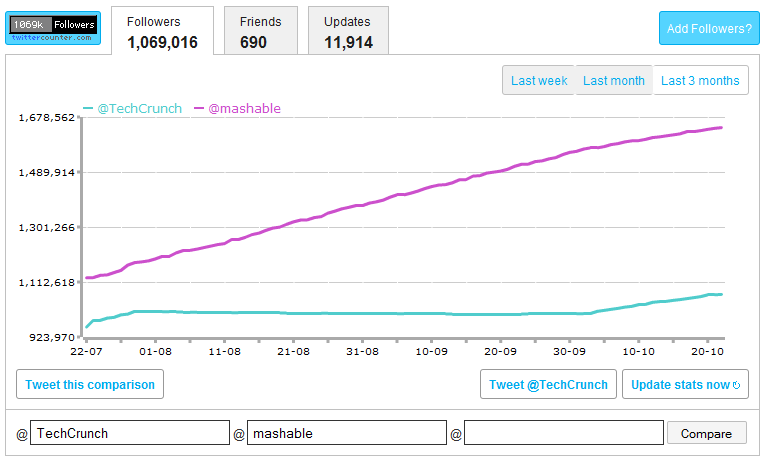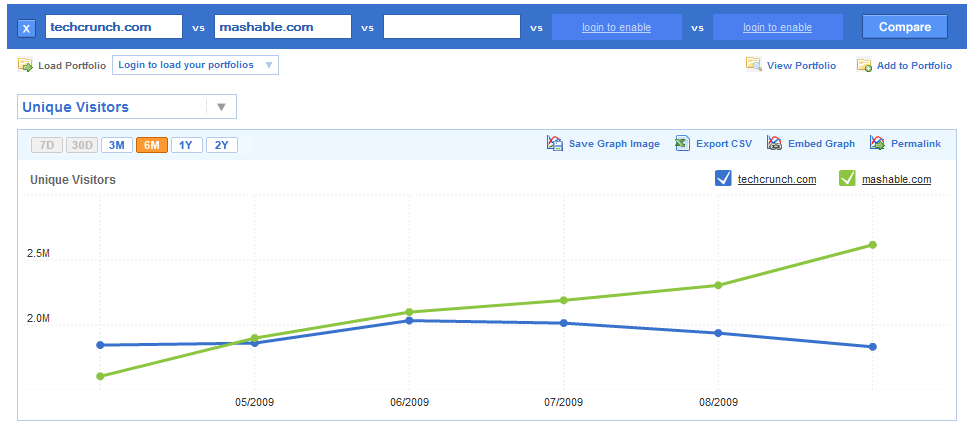Last month I wrote about the dillema TechCrunch found themselves in after TwitterGate. The problem arose when Twitter removed TechCrunch from their Suggested User List (SUL). It now seems that Twitter has recently taken TechCrunch’s key rival, Mashable, off the list as well.
This gives us an interesting point of comparison. The first graph here shows Twitter follower count for both TechCrunch and Mashable through August. Total flat line for TechCrunch as Mashable continues to grow.
Then we see what an extra month brings. Notice anything interesting? Yes, TwitterCounter got a face lift but do you see something else? On the 3rd of October something happened to both accounts. There’s a noticeable bump as TechCrunch begins to gain followers. There’s also a very slight change in Mashable’s trajectory. It’s very small and not quite equal to TechCrunch’s new growth but I find this deliciously fascinating that it happened on the exact same day. My guess is that this is the day Mashable came off the SUL. That would explain the slowed decline but why TechCrunch’s rebound? It could be that when people no longer were recommended Mashable they began looking around for their tech geek news. This is pure speculation of course.

TechCrunch vs Mashable
The bad thing about Compete is that it lags a month behind. We don’t have current traffic data but let’s look at what an extra month of Mashable on the SUL did. Here’s the last report.
As expected TechCrunch continued to loose traffic and mashable continued to grow. I find it interesting that both of their trajectories accelerated. I’m very, very curious to see what happens with next months data. Will TechCrunch begin to rebound? Will Mashable’s growth slow? Any bets? My theory is that we’ll see their site traffic begin to mirror their Twitter follower growth.

TechCrunch vs Mashable Web
I talked about the immense power this gave Twitter. Apparently like revenue, Twitter isn’t comfortable with that power. At the Web 2.0 Conference Ev revealed that the new feature, Twitter lists that are still in beta will replace the SUL.
This effectively distributes the power that Twitter holds and spreads it over it’s millions of users. While Twitter looses the direct influence it held, I’d argue that the accumulation of all those distributed lists is greater than the the one individual list.
This has always been Twitter’s strength. Taking the accumulated power it holds and distributing that freely across it’s network. They’ve done this with app developers, users - everything really.
Related articles by Zemanta
- STATS: Facebook and Twitter’s Growth Flattens (frontofficebox.com)
- These are the Early Days of Social IT Investment (newcommbiz.com)
- Twitter for News and Facebook for Tech? (newcommbiz.com)
- Social Media [Insert Made Up Buzzwords Here] (newcommbiz.com)
- The State of the 2009 Blogosphere? Turning it up to 11! (newcommbiz.com)